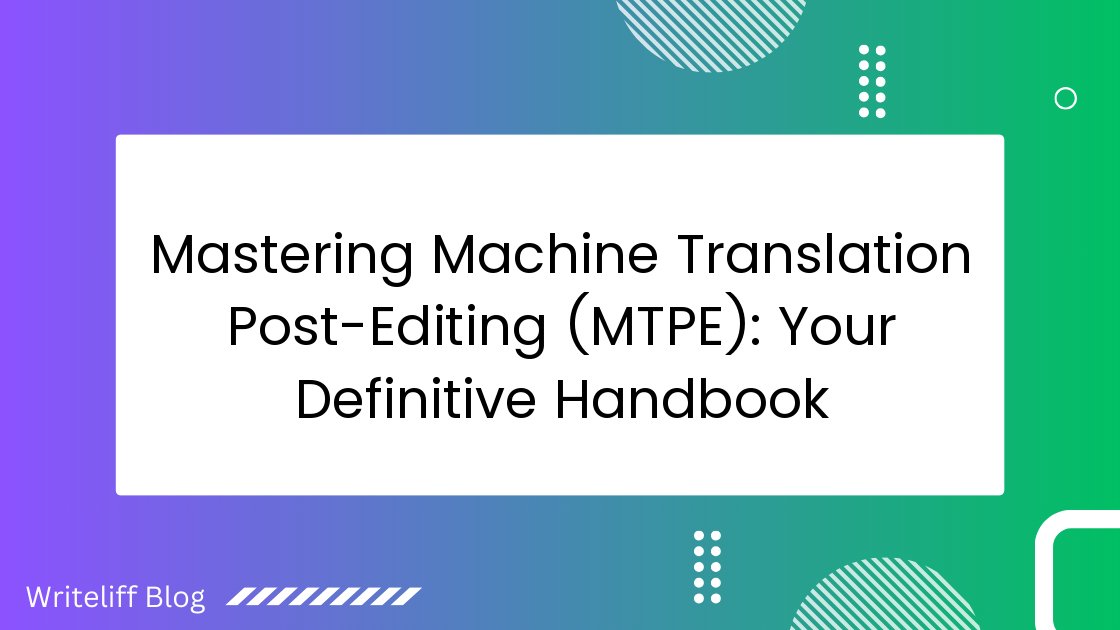Mastering Machine Translation Post-Editing (MTPE): Your Definitive Handbook

Greetings, fellow translation professionals! As the owner of a successful translation company, I understand the importance of delivering accurate and high-quality translations to clients. In today’s fast-paced world, machine translation has become an indispensable tool in our industry. However, as powerful as machine translation may be, it still requires the expertise of human translators to fine-tune the output and ensure top-notch quality. This is where Machine Translation Post-Editing (MTPE) comes into play. In this comprehensive guide, I will walk you through the essential techniques and strategies to master MTPE and deliver exceptional translations. Let’s dive in!
The Role of Machine Translation Post-Editing
What is Machine Translation Post-Editing?
Machine Translation Post-diting is the process of revising and refining machine-generated translations by human translators. It involves correcting errors, improving readability, ensuring consistency, and enhancing overall quality.
Why is MTPE Important for Translation Companies?
MTPE offers numerous benefits to translation companies, such as:
- Increased Efficiency: By leveraging machine translation, translators can handle larger volumes of work in less time.
- Improved Consistency: MTPE ensures that translations are aligned with established terminology and adhere to consistent style and tone.
- Enhanced Quality: Post-editing helps eliminate errors and inaccuracies, resulting in polished and professional translations.
- Cost Savings: MTPE allows companies to offer competitive pricing while maintaining high standards of quality.
Best Practices for Machine Translation Post-Editing
1. Understand the Source Text
Before starting the post-editing process, it’s crucial to thoroughly comprehend the source text. This understanding helps you identify potential translation errors and ensures accurate and contextually appropriate revisions.
2. Maintain Target Audience Expectations
Consider the target audience and the intended purpose of the translation. Make sure the post-edited version matches the expectations of the end-users, taking into account cultural nuances and preferences.
3. Focus on Key Elements
During the post-editing process, pay special attention to the following elements:
- Grammar and Syntax: Correct any grammatical errors, sentence structure issues, and syntactic inaccuracies.
- Terminology Consistency: Ensure consistent usage of terminology throughout the translation, adhering to established glossaries and client preferences.
- Style and Tone: Adapt the style and tone of the translation to match the client’s requirements, whether it’s formal, informal, technical, or promotional.
4. Collaborate with Machine Translation Systems
Make the most of machine translation systems by leveraging their capabilities and integrating them into your post-editing workflow. Use the feedback generated during the MTPE process to train and improve the machine translation engine, ultimately enhancing its output for future translations.
5. Develop Customized Post-Editing Guidelines
Establishing clear post-editing guidelines specific to your translation company will help ensure consistency across projects. These guidelines should include instructions on handling common issues, preferred terminology, and any specific client requirements.
Benefits and Limitations of Machine Translation Post-Editing
The Benefits of MTPE:
- Improved Efficiency: MTPE allows you to handle larger volumes of translations within tight deadlines.
- Enhanced Consistency: Post-editing ensures consistent terminology and style across translations.
- Cost-Effectiveness: By leveraging machine translation, you can offer competitive pricing without compromising quality.
- Training Machine Translation: Feedback from MTPE can be used to train and refine machine translation engines, improving their accuracy over time.
The Limitations of MTPE:
- Complex Texts: MTPE may not be suitable for highly complex texts, such as legal or medical documents, which often require specialized knowledge and expertise.
- Contextual Understanding: Machines may struggle to fully grasp nuanced contexts, leading to potential errors that require human intervention.
- Post-Editing Time: Depending on the quality of the initial machine translation output, post-editing may still require a significant amount of time and effort.
Conclusion: Achieve Translation Excellence with MTPE
In conclusion, mastering Machine Translation Post-Editing is a crucial skill for any translation company aiming to provide high-quality translations efficiently. By following the best practices outlined in this guide and leveraging the benefits of MTPE, you can take your translation services to the next level. Embrace the power of machine translation, combined with the expertise of human translators, and unlock a world of possibilities in the realm of language services. Happy post-editing!